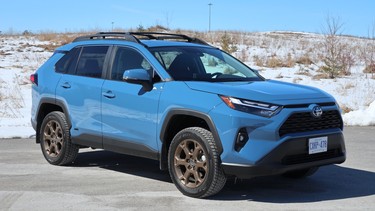There’s a new Woodland trim this year, and updates to the safety and infotainment systems

Article content
You shouldn’t buy a vehicle simply because it’s popular, but it’s worth checking it out to see why so many people are buying one. In this case, it’s the 2023 Toyota RAV4. It’s not only the top-selling Toyota, but typically the country’s top-selling SUV overall.
Advertisement 2
Article content
In any given category — price, cargo space, performance — it doesn’t dramatically overshadow its competitors in the crowded compact SUV segment. Instead, it’s a balanced package that does just about everything right.
Canadian pricing for the 2023 Toyota RAV4 Hybrid
The RAV4 lineup starts with a conventional gas-only model, starting at $32,950. I drove the RAV4 Hybrid, which seems to be the prevailing one with buyers, given that it comes in eight trims, while the regular gas model offers five. There’s one more step up to the RAV4 Prime, a plug-in hybrid (PHEV) that travels a rated 68 km on battery-only after it’s been charged, but it’s far pricier.
The hybrid starts at $34,850 in LE trim, while I had the next-step up XLE at $37,990. The hybrid lineup tops out with the Limited at $45,850. My tester was further optioned with the new-for-2023 Woodland package, which added $2,190. As the name suggests, it’s intended for the outdoorsy crowd with its TRD off-road-tuned suspension, 120-volt power outlet, all-weather floor mats, cargo tray, roof rails with cross bars, and an eye-catching set of bronze-colour TRD 18-inch wheels.
Advertisement 3
Article content
Advertisement 4
Article content
Along with that new trim, all RAV4s get a new Toyota Multimedia system for 2023. It includes wireless Android Auto and Apple CarPlay instead of the previous cable requirement, plus trials for subscription-based features including a digital assistant and remote access through an app. The standard driver-assist safety features, which include adaptive cruise control, blind-spot monitoring, lane-keep assist, and emergency front braking, are upgraded this year with assist at intersections. The RAV4 will automatically brake if you don’t stop for oncoming traffic when turning left; or when you’re turning in either direction, it will identify and brake for pedestrians if you don’t.
The XLE hybrid is $1,640 more than its non-hybrid sibling in that trim, but I think it’s money well spent. Not only is the hybrid more fuel-efficient — officially rated at 6.0 L/100 km in combined city/highway driving, versus 8.5 for the gas-only version — but I find it smoother and more pleasant to drive. It’s not a powerhouse, and the engine can get noisy on hard acceleration, but for most driving conditions it’s just fine.
Advertisement 5
Article content
-
![The 2023 Toyota Prius Prime is fast, furious, and frugal]()
The 2023 Toyota Prius Prime is fast, furious, and frugal
-
![First Look: 2024 Toyota Grand Highlander]()
First Look: 2024 Toyota Grand Highlander
An engine that gets some hybrid help with electricity
Both the gas-only and hybrid versions use a 2.5L four-cylinder engine, but the hybrid combines it with electric motors, for a total of 219 horsepower along with 163 lb-ft of torque. The hybrid system automatically switches between gasoline, electricity or a combination, depending on driving conditions, and it’s very smooth and often imperceptible when it switches over. It self-charges the battery through regenerative braking. I also drove the gas-only RAV4, and it felt wasteful whenever I’d decelerate and it just slowed down, without capturing all that energy to be used again as electricity.
Advertisement 6
Article content
The RAV4 Hybrid’s gas-electric power goes to the front wheels through an automatic continuously-variable transmission (CVT). All RAV4 models are all-wheel drive (AWD), but while the gas-only version has a mechanical connection to the rear wheels, the hybrid has another electric motor devoted strictly to those back tires. It powers them up when extra traction is needed, whether it’s to get out of snow or mud, or more control on a curve. The Woodland has a “Trail” driving mode that further optimizes use of the rear wheels when you’re off the pavement. There’s also a button for EV (electric vehicle) mode on the console, but it’s really just wasting space there. It only keeps the RAV4 on battery-only at low speeds, which the system does anyway, and it doesn’t take much pressure on the throttle to override it and shut it off.
Advertisement 7
Article content
Advertisement 8
Article content
Seating for five, with easy-to-use controls
The RAV4 has seating for five, and overall, it’s a comfortable vehicle, with supportive seats and good headroom. There isn’t quite as much rear-seat legroom as with competitors such as the Honda CR-V or Hyundai Tucson, but there’s still enough leg space that most passengers will be fine back there. At 1,059 litres of cargo space, it’s mid-pack among rivals in the segment, and I like that the liftgate has a wide-and-low opening so it’s easy to stash items inside.
Compare the specs of similar hybrid SUVs
I also like the simplicity of the controls, with large dials to adjust the cabin temperature, and buttons for the fan speed and vent mode, as well as the two-level heated seats and heated steering wheel. For 2023, most trims upgrade from the previous seven-inch centre infotainment screen to eight inches (the top-line Limited goes from nine-inch to a 10.5-inch display). The screen is no longer surrounded by hard buttons that bring up the menus, but the row of menu icons behind the glass are intuitive and the functions are easy to use, and there’s still a dial for volume, as there always should be. Also included are five USB charging ports.
Advertisement 9
Article content
My XLE — the Woodland is an additional option package on it — is one trim above the base LE, and includes a power liftgate, power driver’s seat, dual-zone automatic climate control, tonneau cover, rain-sensing wipers, and power sunroof.
No vehicle is all things to all people, but the RAV4 gets a lot of things right. Nothing about it is spectacular, but it all combines into a well-done package that’s comfortable to drive, fuel-efficient and intelligently-priced. It’s not the only choice in the compact hybrid segment, but it’s a worthwhile contender.
Pros
✔ Fuel economy
✔ Almost-seamless switch between gas and electricity
✔ Simple and intuitive controls
Cons
✘ Rivals have more rear-seat room
✘ Engine gets noisy on hard acceleration
✘ Don’t expect much from the “Electric Vehicle” driving mode button
Stay connected with us on social media platform for instant update click here to join our Twitter, & Facebook
We are now on Telegram. Click here to join our channel (@TechiUpdate) and stay updated with the latest Technology headlines.
For all the latest Automobiles News Click Here





Comments
Postmedia is committed to maintaining a lively but civil forum for discussion and encourage all readers to share their views on our articles. Comments may take up to an hour for moderation before appearing on the site. We ask you to keep your comments relevant and respectful. We have enabled email notifications—you will now receive an email if you receive a reply to your comment, there is an update to a comment thread you follow or if a user you follow comments. Visit our Community Guidelines for more information and details on how to adjust your email settings.
Join the Conversation